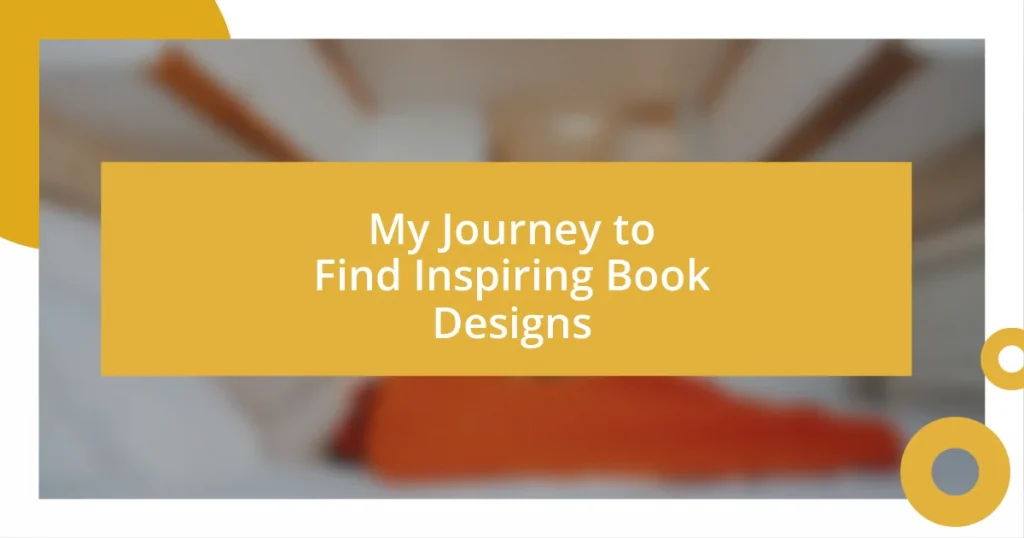Key takeaways:
- Sources of inspiration for book design include personal experiences, art, and nature, emphasizing the emotional impact of visual elements.
- Understanding design styles, such as minimalism and eclecticism, enhances storytelling through effective visual representation.
- Applying layout techniques, selecting appropriate typefaces, and incorporating tactile elements can significantly elevate the reader’s experience.

Identifying sources of inspiration
Finding sources of inspiration can often feel like a treasure hunt. I vividly remember flipping through old magazines at my grandma’s house, where the vibrant cover designs transported me to a different time. Those moments sparked my interest in design because they showed me how something as simple as a book cover could evoke deep emotions and tell a story all on its own; isn’t it fascinating how visual elements can resonate with us so profoundly?
Exploring art galleries and museums has been another goldmine for inspiration. The way colors interact in a painting can ignite an idea for a book cover that I never would have considered otherwise. Have you ever stood in front of a piece of art and felt an overwhelming urge to create? I’ve had countless experiences where a single painting has ignited a flurry of ideas, illustrating how art can break down barriers and open up new creative pathways.
Another source I cherish is nature. Walking through a park or hiking up a trail allows me to observe how organic designs and patterns work together harmoniously. I often find myself enchanted by the intricate details of a flower or the way light plays on leaves, reminding me that beauty is everywhere — if we just take the time to look. What natural elements do you find inspiring? For me, these experiences remind me that inspiration can arise from the simplest aspects of life, urging me to infuse that same vibrancy into my designs.

Exploring different design styles
When I dive into the world of design styles, I often find myself reflecting on how each one tells its own unique story. For instance, minimalism, with its clean lines and ample white space, evokes a sense of calm and clarity. I remember the first time I stumbled upon a minimalist book cover; it felt refreshing and thought-provoking, almost like a breath of fresh air. On the other hand, I’ve encountered vibrant and eclectic styles that burst with color and texture, instantly captivating my attention and sparking my imagination.
Here are some design styles I’ve explored:
- Minimalist: Focuses on simplicity and clarity, emphasizing functionality over ornamentation.
- Vintage: Draws inspiration from past eras, often incorporating intricate details and nostalgic elements.
- Eclectic: A bold mix of various styles, inviting creativity and personal expression.
- Modern: Emphasizes clean lines and innovative materials, typically with a forward-thinking approach.
- Illustrative: Features hand-drawn elements or illustrations, conveying personality and warmth.
Each of these styles has resonated with me in different ways, shaping my understanding of how a book’s design can enhance its narrative. Whether a design is sleek or whimsical, every choice can evoke emotions and engage readers on a deeper level.

Learning about effective layout techniques
Learning about layout techniques has truly transformed the way I approach book design. I recall a time when I experimented with grid systems, which helped me create balance and structure in my work. I remember feeling a sense of triumph when everything clicked into place and the layout flowed cohesively — it was as if I had discovered a secret formula to guide my design choices. Isn’t it incredible how a well-organized layout can elevate a reader’s experience?
I’ve also delved into the principle of contrast. This technique became apparent to me when I worked on a project featuring bold typography against a soft background. The resulting visual tension not only captured my attention but also made the text more legible. The moment I realized how these contrasting elements could direct the reader’s focus, everything changed. Have you ever played with contrasting colors or fonts? It’s like orchestrating a symphony of visual elements that dance together seamlessly.
Moreover, I’ve learned the importance of white space, which can sometimes feel daunting. Initially, I hesitated to leave areas blank, fearing it would diminish my design’s impact. However, embracing white space has allowed my designs to breathe. I vividly recall a project where I intentionally left significant gaps, resulting in a polished and modern aesthetic. It was a game-changer! The balance between content and spacing can communicate sophistication and clarity — a lesson I value dearly in my design journey.
| Technique | Description |
|---|---|
| Grid Systems | Structure and balance that enhances the overall coherence of the layout. |
| Contrast | Creating visual tension to improve focus and readability through opposing elements. |
| White Space | Using empty space to create a clean, sophisticated look and provide breathing room for content. |

Finding professionals in book design
Finding the right professionals in book design can feel like searching for a needle in a haystack, but it doesn’t have to be overwhelming. I remember scouring online platforms like Behance and Dribbble, which are treasure troves of creative talent. Each profile felt like a glimpse into the designer’s mind, showcasing not just their skills but their unique perspectives on storytelling through visuals. Have you ever experienced that moment of finding a designer whose work resonates with your vision? It’s like having a shared understanding right from the start.
Networking also plays a crucial role in connecting with talented designers. I once attended a local book fair and stumbled into a workshop led by an inspiring designer. Engaging with professionals in person allowed me to hear their stories, pick their brains, and even foster some friendships. This personal interaction transformed my appreciation for their craft and opened doors to collaborations I hadn’t anticipated before. If you have the chance, I urge you to step into local events — you never know who you might meet!
When evaluating potential designers, it’s essential to look beyond their portfolio. I’ve found that a brief conversation can reveal much about their creative process and how they approach projects. I recall interviewing a designer who articulated their belief in the importance of aligning design with the book’s narrative, and that perspective resonated with me deeply. As you seek out professionals, consider not only their aesthetic but their philosophy behind design; it can make all the difference in translating a story into a compelling visual experience.

Showcasing my favorite designs
One of my absolute favorite book designs features intricate hand-drawn illustrations that pull you into the narrative. I vividly remember thumbing through a fantasy novel where every chapter opening was adorned with an enchanting artwork that captured the essence of the story. That experience was magical—the illustrations didn’t just complement the text; they enhanced my imagination. Have you ever encountered a book where the visuals made the words leap off the page?
Another design that struck a chord with me was a minimalist cover that used typeface and color to convey an entire mood. I still can’t shake the feeling of intrigue I felt while eyeing a slender volume wrapped in a rich, deep blue with gold lettering. It was almost as if the design whispered, “Open me to explore my depths.” That’s powerful, right? It’s fascinating how a simple design can evoke such strong emotions and curiosity.
Then there’s the modern touch of layering textures and materials that I can’t get enough of. I once came across a cookbook that employed a tactile cover, complete with embossing that made it not just a feast for the eyes, but also for the hands. It reminded me of the joy of baking—how the feel of dough can bring memories flooding back. Don’t you think the physicality of a book can enhance the reading experience in such profound ways? Each time I explore designs like these, I’m reminded of how deeply interconnected visual artistry and storytelling truly are.

Applying lessons to my projects
When applying the lessons I’ve learned about inspiring book designs, I often revisit those moments that struck a chord with me. For example, while developing my own projects, I experimented with integrating illustrations that resonate with the theme. I remember the rush of excitement when I collaborated with an illustrator on a passion project. The results were electrifying! The visuals transformed the text into something dynamic and engaging, making me wonder—how could I have overlooked the power of imagery before?
One critical takeaway has been the importance of choosing the right typeface. I recently undertook a project where selecting just the right font felt like finding a voice for the narrative itself. I played around with various typefaces, ultimately leaning towards one that conveyed both elegance and approachability. The moment I saw the layout come together, I felt a wave of satisfaction. Have you ever experienced that sensation when a design element clicks into place? It’s a blend of relief and joy that fuels my passion for design.
Furthermore, I’ve realized that tactile elements are not just optional; they can elevate the entire reader’s experience. During a recent project, I opted for a textured cover that drew readers in, almost inviting them to reach out and touch it. I still vividly recall a conversation with a colleague who emphasized how a book’s physicality can forge a connection with readers. That conversation sparked a new direction for my work—what if I could create not only a visual feast but also an experience that engages all the senses? It’s fascinating how these insights continue to shape my approach to design, reminding me that every project is an opportunity to connect deeply with readers.















